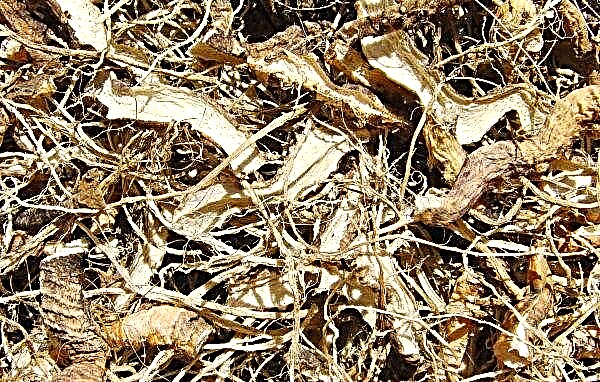Ficus is one of the most popular plants both in houses and apartments, and in office premises. But often when growing it, you may encounter the fact that the leaves of the flowerpot begin to turn black. What it can be connected with and what needs to be done in this case - read on.
Basic rules for growing ficus
Florists often express the opinion that ficus is a rather capricious and whimsical crop to care for. However, this is not quite true.
Did you know? In India, the long roots of the rubber ficus are used to create “living” bridges. They do this with the help of bamboo poles, along which the roots gradually "move" to the opposite bank. The length of such green bridges can reach 30 m, and they serve for a very long time, some for several centuries.
An evergreen requires compliance with the same growing rules as any other flower, namely:
- Providing sunlight - culture is photophilous.
- Compliance with the rules of moisturizing. Violation of this rule can lead to various ailments, in particular to blackening of leaves along the edges.
- Organization of the summer shower. In hot weather, the air around the tropical flower needs to be additionally moistened by spraying.
- Compliance with the rules of transplantation, which should be carried out every year (the optimal time is mid-March). The method of transplantation is transshipment. In case of improper transplantation, the roots of the plant can be damaged, which will subsequently provoke blackening of the edges of the leaves.
- Proper and moderate top dressing.
- Carrying out hygiene procedures - removing dust with a sponge or under a warm shower.
- Glossy foliage to give it a special gloss.

Why ficus leaves turn black
The culture has a number of requirements for the grower, the violation of which may be the reason that the leaves of the ficus turn black. Learn more about this.
Excess or moisture deficit
One of the main causes of blackening of ficus leaves is excessive moisture. The amount of watering depends on the time of year, and on the age of the pot, and on environmental conditions.
Experienced growers recommend watering 2 times a week. In this case, it is worth checking whether the flower needs moisture. For watering, warm water is needed, which is poured on top of the substrate until it is completely covered with water and it begins to flow out of the drainage holes. 30 minutes after the procedure, drain the accumulated water in the pan.
A lack of moisture can also adversely affect the flower and cause darkening of the foliage. Such an unpleasant phenomenon acquires particular relevance in hot summer days. Therefore, carefully check the quality and level of soil moisture.
Important! To check if the plant needs moisturizing, it’s worth trying to touch the ground - deepen the finger into the soil by 3-5 cm. If the finger remains dry, then the flowerpot should be watered, if the soil sticks to the finger — he does not need hydration.
Confirmation that the reason for the darkening of the edges of the ficus leaves is in improper hydration are the following facts:
- the topsoil does not dry out for a long time and a crust forms on it;
- foliage becomes lethargic, loses elasticity;
- when rubbing the blackened areas, moisture is released, and these areas themselves are quite soft;
- the soil begins to spread an unpleasant, musty smell.

Lack of useful components in the ground
If you carefully follow the rules of irrigation, and the ficus leaves still darken, then, possibly, the lack of fertilizers.
Therefore, you should carefully familiarize yourself with the organization of the plant feeding procedure:
- In summer and spring, ficus needs mineral and organic fertilizers. You can feed him with such means as “Ideal”, “Kemira”, “Giant”, “Rainbow”, “Palm”, “Gumisol”. Fertilize the pot with a solution of the listed funds, strictly observing the instructions. Frequency of feeding - every 10-14 days.
- In autumn, the amount of top dressing is reduced to 1 time per month.
- In winter, the culture hibernates, so there is no need to fertilize it.
The reason for the darkening of deciduous edges may be a lack of nitrogen in the soil, especially during the period of active growth of ficus in the spring and summer. In the fall and winter, on the contrary, the introduction of nitrogen-containing products should be stopped.
Important! After the transplant, the ficus can not be fed for 2 months, since the substrate contains enough nutrients to ensure the normal functioning of the flower.
Poor irrigation water quality
It is strictly forbidden to water ficus with cold water, especially on hot days - this can lead to so-called root burns. Due to such watering, the roots of the culture become sick, and outwardly this is expressed by the blackened edges of the foliage. The optimum water temperature for humidification is + 20 ° C. In addition, the liquid must be filtered and infused.
Wrong place choice
Ficus extremely does not welcome the change of residence, so even at the stage of planting, you need to carefully consider where he will stand.
When choosing a place, the following criteria should be considered:
- Lighting level. Culture belongs to the number of photophilous, but at the same time reacts poorly to direct sunlight. Therefore, you need to make shading for the ficus.
- Temperature indicators. The plant will feel great if in summer it is provided with an air temperature of + 25 ... + 30 ° С, and in winter - + 16 ... + 20 ° С. The minimum temperature in which the ficus can be located is + 10 ° С.
- Humidity percentage. Despite its tropical origin, ficus does not welcome high humidity in the atmosphere. Optimum performance is 50–70%.
If these requirements are not observed, the ficus can express its dissatisfaction with the blackened foliage. An ideal place for a flower is the east side of the house.
Did you know? The oldest ficus grows in Buenos Aires. It was planted back in 1781. Now it is an impressive tree, which is called the "tree of Homer."
You can not choose a place for this plant close to heating objects (batteries) and heaters. In winter, to prevent air drying out, it is necessary to spray the flower with warm and soft water 1-2 times in 7 days.
What to do so that the leaves of the ficus do not darken
So that the ficus foliage does not darken, it is necessary to carry out preventive measures:
- Protect the plant from direct sunlight: its leaves can get burned and soon darken.
- Make sure that in winter the soil under the ficus does not get too wet, and in the summer it does not dry out.
- Protect the flowerpot from drafts, which can provoke the appearance of the described foliage disease.
- Properly prepare the container for planting: it must be well-drained.
- If, even if all of the above rules are observed, the plant is still sick, then it must be transplanted into a new substrate, mixing equal parts of sand, sheet soil and peat.
You can avoid problems with growing ficus with regular inspection, proper care, and removal of damaged leaves.
Useful Care Tips
Experienced growers share some of the secrets of growing ficus:
- You can’t move the flowerpot from place to place - he does not like to be touched, moved, disturbed. The response of the plant to such actions will be its oppression, a dull camp, blackening of foliage.
- When caring for foliage, be very careful: the ficus milky juice contains toxic substances. Also make sure that children or animals do not chew the flowerpot leaves.
- Do not buy ficus in the fall or in the winter: at this time it will be very bad to take root in a new place.
- Inexperienced flower growers believe that the larger the plant, the better. But this is not so: adaptation of an adult plant to new living conditions will be long and difficult.
- Check the root system of the plant regularly. To do this, just look at the roots through the drainage hole: if they have acquired a black or brown color, then the culture is sick.
 Apparently, the ficus is not so capricious as they say about it. However, like all indoor plants, it requires care, which does not take much time and effort, but its bright green foliage will always be pleasing to the eye.
Apparently, the ficus is not so capricious as they say about it. However, like all indoor plants, it requires care, which does not take much time and effort, but its bright green foliage will always be pleasing to the eye.












